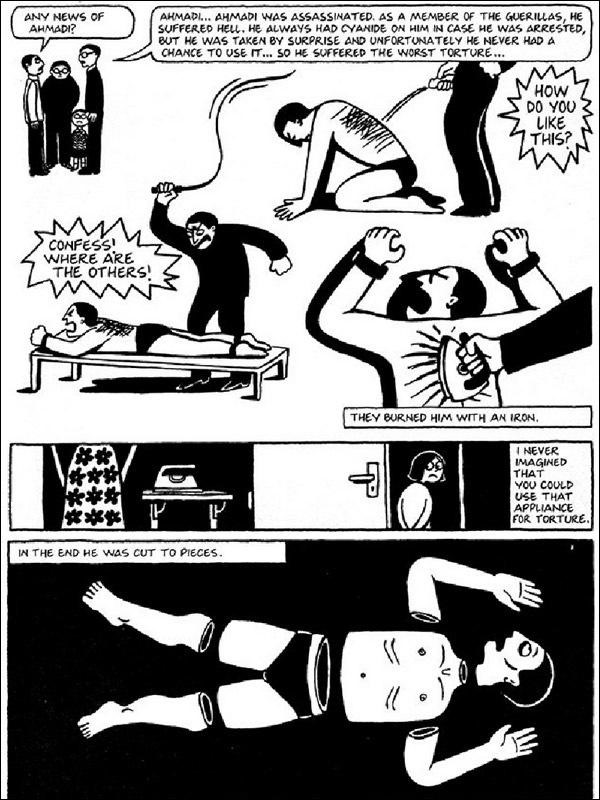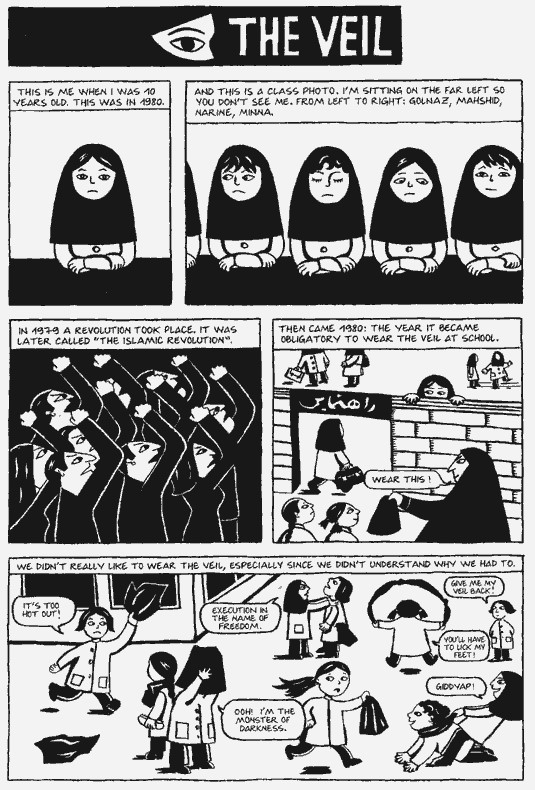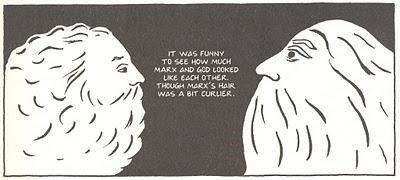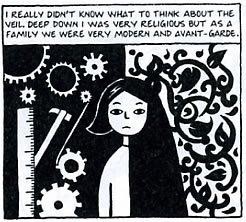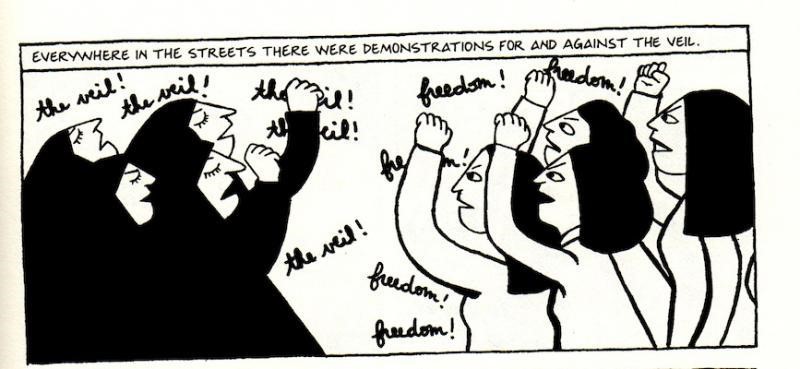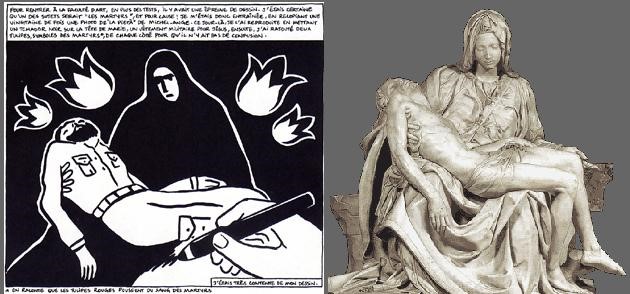“At the time, Iran was the epitome of evil and to be Iranian was a heavy burden to bear….[Yet] the more time passed, the more I became conscious of the contrast between the official representation of my country and the real life of the people, the one that went on behind the walls” —Marjane Satrapi
In Ideology and Ideological State Apparatus, Louis Althusser introduces the concept of ideological interpellation. This attests that ideology becomes a facet of one’s identity as one encounters cultural values and internalizes them. By disseminating the fallacious view that ideologies cannot coexist because they are mutually exclusive, society breeds ideological battles. The result is an antithesis between the “real life” of a people and the ideological stance—the “official representation” attributed to the nation. The same decade that Althusser reformed the discipline of philosophy, the 1970s, Italian feminists who were part of the Women in Black, Israeli-based anti-war movement, coined the term transversalism. Transversalism refers to the “process by which people designated as enemies or others form new understandings of each other … create spaces in which militarized ethno/national identities are examined and reworked.” Transversalism is thus a reaction to the binary conceived by ideological interpellation.
Marjane Satrapi’s graphic novel Persepolis is one form of a transversal response to the Western interpellation of Iranian culture, religion, and government as part of the “axis of evil.” A phrase first coined by George W. Bush in his 2002 State of the Union Address, “the axis of evil” has become a frame for policymakers to influence public perceptions of the Eastern world, specifically Iran. By narrating and sketching a graphic memoir of herself as an audacious, leftist female Muslim who dislikes the veil, protests against Shah Mohammed Reza Pahlevi on the Black Friday Massacre, and dissents against Ayatollah Khomeini’s extremist regime, Satrapi establishes that Iran is not an axis of evil, but rather an axis of selective acculturation that allows her to vacillate between Eastern and Western quadrants. Satrapi uses the motif of the mirror and a black-and-white color palette to refute the socially constructed dichotomy between Iranian and Western ideologies. Through her two-dimensional medium, she counters a one-dimensional portrayal of Iran as a repressive, terrorist nation.
Historicizing Narrative
“[The State] proposed the following choice to the detainees: either they could renounce their revolutionary ideas, and promise fidelity and loyalty… or they would be executed. And, well, most of them were executed” — Satrapi
Between October 12 and 17 in 1971, Mohammed Reza Shah Pahlevi commenced an extravagant festival to memorialize the 2,500th anniversary of Cyrus the Great’s naissance of the Persian Empire at Persepolis, the capital of the Achaemenid Empire. A $200 million venture, the Persepolis celebration both demonstrated the Shah’s attempt to reiterate the role of Iran as a nation that was comparable to America and Europe in capitalistic ventures and established the ancient city as a symbol of Iranian grandeur.
In response to Ayatollah Khomeini’s labeling of the commemoration as the “Devil’s Festival,” the Shah told Indian journalist R. K. Karanjia that Persepolis was a necessary bastion of a longstanding monarchical tradition. These sentiments reinforced that the gala of pre-Islamic, Iranian history demonstrated fervent nationalism and a secular emphasis on Iranian culture, as opposed to religion. “Iran never lost its ethos…the legacy of Cyrus, this flaming Aryan torch of ours, has been kept alight and passed on through our history…linking the past to the present and insuring the future,” remarks former Professor of Eastern, Iranian, and women’s history at the University of California, Los Angeles Nikkie R. Keddie in Roots of Revolution: An Interpretive History of Modern Iran. Satrapi’s decision to title her memoir Persepolis reflects her emphasis on historicizing her narrative—on reinforcing the sumptuous, worldly image of Iran that Persepolis encompasses and George W. Bush’s label of vice shrouds:
…[T]his old and great civilization has been discussed mostly in connection with fundamentalism, fanaticism, and terrorism. As an Iranian who has lived more than half of my life in Iran, I know that this image is far from the truth…I believe that an entire nation should not be judged by the wrongdoings of a few extremists. I also don’t want those Iranians who lost their lives in prisons defending freedom, who died in the war against Iraq, who suffered under various repressive regimes, or who were forced to leave their families and flee their homeland to be forgotten.
Persepolis is thus an effort to maintain the burning flame of the Aryan torch by illuminating the egregiousness of the binary between the Western opinion of the East—determined by the “wrongdoings of a few extremists”—and the reality of the East—veiled by Western opinion; history is the vehicle through which this enlightenment occurs. Satrapi’s deliberate inclusion of the leftist revolutionaries’ dissent against both the Shah supplements her intent to supplant the social construct of interpellation with open-mindedness.
The Iranian Revolution parallels the revolution in ideology Satrapi expects readers to undergo in the discourse of the novel. Her enhancement of the role of Marxist leftists in galvanizing the Revolution rebuts the Western observation that the Revolution exemplifies the regressive, theocratic nature of Iranians, and thus suggests the coexistence of both hemispheric ideologies. Through her chapter “Heroes,” Satrapi establishes that Marxism was the fuel that ignited opposition to the Shah. In 1975, the Shah founded the Rastakitz Party, Iran’s single political party in which all Iranian citizens required membership. A manifestation of monarchy, the Rastakitz Party signified the government’s desire to stifle the burgeoning communist Tudeh Party’s attempts to rectify the income inequality that flourished under the Shah. Satrapi’s decision to highlight the tortuous punishment of the Marxist guerilla Ahmadi demonstrates not only her criticism of the Shah’s secret police, the SAVAK, but also her recognition of secular nonconformists’ efforts in propelling the Revolution. By emphasizing the leftists’ contributions to the Shah’s overthrow as opposed to those of the Islamic mullahs, Satrapi invites her audience to accept the proposition that the Revolution is a repudiation of the ideological dichotomy. Contrary to the Western view of the movement as one of a deterioration to archaic Eastern values, the Revolution emerges as a symbol of Marxist valor. The depiction of Ahmadi’s fate in a still frame attests to Satrapi’s motive use of history as justification for the lack of a legitimate dichotomy between the East and West.
The prisoner’s white body is divided; his arms, torso, and legs are dismembered, lying luminescent against a black backdrop. The fragmentation of Ahmadi’s body serves as a metaphor for the destruction of ideological interpellation that Satrapi initiates. By partitioning the Iranian Revolution into separate causes and underscoring the cause of Marxist dissent, she tears the Western view of the Revolution as a theocratic symbol. Satrapi thus “re-frames conceptions of Iran by framing an autobiographical history in the context of her view of Iran’s national history,” as indicated by English professor Lisa Botshon in the journal, Feminist Teacher.
Looking Through the Glass at an Identity Crisis
“I was a Westerner in Iran, an Iranian in the West. I had no identity. I didn’t even know anymore why I was living.“— Satrapi
In Seeing Through Clothes, art historian Anne Hollander suggests that the “mirror is the personal link between the human subject and its representation—a medium for the self-deceptive image of the subject.” Hollander’s assertion attests to the pervasive use of the motif of the mirror in Persepolis. Satrapi uses frames within frames to deconstruct the socially constructed hemispheric division and deliberately project a one-sided view of how the hemispheres intersect. The recurring act of perceiving a reflection additionally depicts the protagonist’s protracted quest for identification and the process of fragmentation that occurs as she vacillates between apparent Iranian and Austrian religious, political, and sexual values. The mirror, however, relies upon the eye of the beholder. Satrapi makes this contingent relationship clear in the opening page of the graphic novel.
In the first chapter, titled “The Veil,” Satrapi deliberately places a single eye over the gutter—the space within the borders. Cartoon theorist Scott McCloud hails this technique as an integral facet of comic narrative. In Understanding Comics, he writes that the gutter establishes the twofold nature of the eye as a symbol of Satrapi’s “penetrating vision” and a symbol of the audience’s insular “frame of mind” that perceives ideology as a binary, rather than a spectrum. The first frame sequence of the novel augments Satrapi’s supervision of the narrative’s projection and readers’ jaundiced, one-sided vision. Satrapi begins by introducing a head to waist sketch of young Marji, adorned in a veil, a few strands of hair rebelliously showing: “This is me. When I was 10 years old. This was in 1980.” The dual sequence continues with a class photo of Marji’s peers with frowns on their faces, disappointed because of the black chadors suffocating their idyllic youthfulness; however, Satrapi asserts that the elbow on the far left—at first glance, an elusive body part— is hers; “And this is a class photo. I’m sitting on the far left so you don’t see me. From left to right: Golinaz, Mahshid, Narine, Minna.” By juxtaposing the sketch of herself fully revealed (as much as she can with the veil), with only her elbow, Satrapi physically marginalizes herself, demonstrating that she has all-encompassing control over the projection of the narrative. She controls how much we see and of what.
It is essential that the audience recognize Satrapi’s influence because only with the knowledge of pre-existing bias can it realize that true perception requires careful scrutiny—can it choose to take a “second glance” at not only marginalized elbows, but also preconceived ideological chasms between the East and West. Satrapi establishes her intent to manipulate the pre-existing “frame of mind” by using her “penetrating vision” to underscore multiple points of view. By conveying her role as a witness of historiography not only implicitly through graphics, but also explicitly through the written medium, Satrapi draws a parallel between herself and her readers. “I was born in a country in a certain time, and I was a witness to many things. I was a witness to revolution.” Readers, like the author, will emerge as witnesses to their own revolution in ideology. As the gutter suggests, the audience must assume the responsibility to inspect what lies behind the facade of a religious, cultural, and social abyss between Iran and Western nations—to use its eyes to tear down the socially stitched veil.
Notwithstanding, the marginalization of Satrapi’s elbow in the second frame reflects not only the promise of a revolution, but also the identity crisis that afflicts Marji as she straddles Iranian and Austrian metaphysical and metaphorical boundaries. The elbow further illustrates the ideological crisis that will no doubt afflict readers during the ideological revolution. The undermining of body parts exemplifies Satrapi’s “self-presentation as fragmented, cut, disembodied, and divided between frames” (The Women’s Review). Thus, the division in identity highlights the resulting fluctuation between Iranian and Western philosophies. Satrapi establishes the function of the mirror as a benchmark for adherence to one’s proclaimed identity through a panel of Marji gazing into a mirror before leaving to Austria for political asylum, on the grounds of Islamic extremism. Marji’s wide eyes indicate her angst at the thought of separation. The aphorism with which she comforts herself underscores the role of the “self” as an individualistic construct rather than a social construct: “I will always be true to myself”; an individual, and not societal interpellation, is the artist that crafts identity. In this frame, Marji’s face, itself, serves as a refutation of the stringent division between the home country, Iran, and the host country, Austria. The audience can only see half of Marji’s face through the reflection, indicating that Marji holds fidelity to only half of herself because she only knows half of her identity; the other half awaits her during the processes of physical and internal migration—when Marji will realize the dual nature of “self.” Since identity is self-constructed, Marji, the constructor, can choose to incorporate facets from both Iranian and Austrian society.
The mirror serves as a challenge to not only Satrapi’s self-asserted role as a progressive Muslim, but also to the audience’s preconceived notions of religion and revolution. The looking glass serves as an interpreter of the bifurcation between belief and secular dissent in the midst of six-year-old Marji’s conversation with a mystical, white, bearded figure. Marji, in her desperate attempt to contribute to the Revolution, places a beret with a red star on her head, and asks the deity if she looks like Che Guevara. The one-sided conversation is followed by a panel of Marji alone, adorned in a patrol cap, gazing into a mirror with an audacious grin, her eyes shifted towards the right as if she is addressing a closely located entity, i.e. God. “Maybe I’ll be even better as Fidel Castro!”. While the first panel depicts Marji in the process of dress-up, her hands atop her head, the second shows Marji fully-dressed, her hands behind her back. The two-panel sequence’s demonstration of the progression from the movement of hands to their stationary stance is a metaphor for the conscious forging of identity. By viewing the reflection of a metamorphosed Marji, the audience arrives at the conclusion that the young girl both creates and assumes the persona of a counter- revolutionary. Not only does the mirror function as a commentary on the formation of identity, but also as a bridge between Islam and Marxism. The role of God as Marji’s listener indicates that, while Marji is a counter-revolutionary, she is a faithful and perhaps paradoxical one at that. In disclosing her admiration for iconic Communists to a religious authority, young Marji makes no distinction between opposing worldviews, indulging in what sociologist Richard Alba considers the “blurring of socially delineated boundaries and assumption of a globalist’s frame of mind.” The shattering of barriers is reaffirmed in her observation about the similar physical portrayals of secularist and religious figures: “It was funny to see how much Marx and God looked like each other. Though Marx’s hair was a bit curlier.”
Her dual allegiance to the concept of revolution and God counter the sweeping generalizations that typify Islam as antithetical to political progress (Gellner). As indicated by RIT English professor Babak Elahi, Satrapi “negotiates identity in a way that explicitly questions existing forms of ideological and psychological framing”, demonstrating that metaphysical faith— specifically Islam and Marxist-inspired rebellion— are not conflicting, but rather complementary, as they both fuel Marji’s desire to upturn the status quo under Mohammed Shah Reza Pahlevi.
The mirror reappears as a re-framer of the audience’s “frame of mind” through its function as the crosser of the cultural chasm between Iranian and English entertainment. Gazing into a poster of Kim Wilde that she received from her parents after their trip to Turkey, teenage Marji emulates the 1980s British pop icon’s posture, angling her arms and hips. The poster is the mirror; Marji is the subject, and Wilde is the reflection.
By erasing the “mechanism of framing” that characterizes the mirror-frame of the God-loving, Marxist-adoring Marji, Satrapi establishes that “lines of cultural exchange are not unidirectional” (Elahi) and thus, are not mutually exclusive. An Iranian girl can perceive herself as a Western star, thereby concocting a new vision that does not distinguish between arbitrary labels. What may appear as a contradictory reflection from the perspective of the Western ideological interpellation becomes a testimony to the fallacy of a clear separation between the East and West. Marji’s decision to sing Wilde’s anthem “Kids in America” in front of the Guardians of the Revolution, as a sign of solidarity with the leftist revolutionaries, exemplifies the use of a Western medium to espouse an Iranian cause. It is the configuration of Marji’s cultural identity through the appropriation of European, North American, and Iranian forms of entertainment that strengthens the concept of identity as adverse to the existence of non-inter-sectional, metaphysical, ideological frontiers.
Creating Gray out of Black and White
“Education is the lethal weapon against all forms of fundamentalism”— Satrapi
Satrapi’s color scheme reflects the ideological binary her memoir serves to debunk. The use of black and white and the commingling of the opposing colors demonstrates the presence of two hemispheres, the East and West, that oftentimes overlap, merging into a gray entity. Thus, the palette is a medium to educate the audience on the absurdity of a fundamentalist, rigid belief in two separate hemispheres with a delineated border. Satrapi identifies the dilemma that arises when coerced to associate with a single culture, religion, and worldview in a split-frame early on in the novel. The panel depicts half of Marji’s body cloaked in a chador, surrounded by a black ornate Persian design against a white background, while the other half exposes Marji’s black hair, surrounded by white scientific symbols that are against a black background: “I really don’t know what to think about the veil. Deep down I was very religious but as a family we were very modern and avant-garde.”
By expressing doubt about the necessity of the veil, labeling her family as avant-garde, and asserting her religiousness, Marji underscores the conflicting gender and religious roles projected onto her by Iranian culture and her liberal family. The inverse color usage in the two halves of the panel exemplify the complexity and crossing of boundaries between Eastern and Western beliefs and practices. The incorporation of both black and white in each half suggests that there is no clear line dividing the hemispheres. Both Eastern and Western ideologies contain remnants of each other.
Satrapi uses the black and white medium to subvert the prevailing paradigm of the emancipated Western woman and the oppressed Eastern woman. The very first page of the book “opens with images of schoolgirls mocking and challenging the new mandate that they wear the veil” (Botshon). By displaying the jovial manner in which the young students entertained themselves with the veils— forming flamethrowers and saddles with the cloth—Satrapi subtly leads her audience to question the contention that all Muslim women accept the veil. Recognizing the function of the veil as a symbol of Eastern decadence through Western eyes, Satrapi assumes the responsibility of displaying Iranian women in a positive light. Through her depiction of a protest in which women in black chadors chant “the veil!”, while facing veil-less women in white blouses chanting “freedom!”, Satrapi demonstrates that just as the West and East are not monolithic, so too are views of the traditional Muslim headscarf. “Everywhere in the streets there were demonstrations for and against the veil.”
The multi-faceted perspectives attest to the frailty of a clear delineation between Islamically-determined feminine behavior and feminism— the frailty of ignoring the validity of an Iranian, Muslim feminist due to a dogmatic conviction in the separation of spheres.
The varying views of the demonstrators are also a metaphor for the process by which readers arrive at a rectified “frame of mind”. The closed eyes of the veiled women and the opened eyes of the veil-less women in the panel symbolize the revolution in ideology that the gutter for the chapter, “The Veil” promises. Originally shut-eyed—like the veiled woman— to the perception of Muslim women as anything other than meek and docile, the audience emerges with a new-found vision —like the veil-less women—of freedom that does not “idealize Western liberal democracy as the answer to the world’s insecurities” (Elahi). Satrapi further demonstrates that “women in Iran do not fade away under the veil into silent, hopeless passivity” (Elahi) by juxtaposing two panels of herself and her peers at the Islamic Azad University. A frame of the young women cloaked in black chadors and underneath, a sketch of them unveiled and adorned with lipstick, their white collarbones and cleavage prominent against black, curve-accentuating dresses. By revealing the discrepancy between reality and appearance, Satrapi suggests that there is no idiosyncratic Iranian woman, as she is a paradoxical hybrid of both Eastern and Western characteristics. “Our behavior in public and our behavior in private were polar opposites.” The panels propose an alternative archetype of the Eastern woman: an Iranian with the audacity to assert both emancipation from the veil and the Western notion of her subjugation.
Satrapi extends her defiance of the socially inculcated outlook of an established division between views on female empowerment by unifying the religious and cultural tropes of both hemispheres. When describing Marjane’s examination for the College of Art at Tehran, Satrapi obliterates the construed ideological dispute by demonstrating the similarities between Islam and Christianity. To pass her drawing qualification, Marjane must draw a picture corresponding to the subject of “The Martyrs.” Through her description of how she “practice[s] by copying a photo of Michelangelo’s ‘La Pieta’ about twenty times,” Satrapi highlights the irony of utilizing an iconic Christian scene to depict the Islamic phenomenon of jihad or martyrdom.
The merging of the two faiths is manifested in the process through which Marjane emulates the Renaissance sculpture. “I reproduced [La Pieta] by putting a black chador on Mary’s head, an army uniform on Jesus, and then I added two tulips, symbols of the martyrs, on either side so there would be no confusion.” The act of veiling Mary and militarizing Jesus reflects not only the “sacrilegious” crossing of the religious fringe, but also the existence of a doctrine that transcends both the East and West: that of sacrifice. The presence of a hand clutching a pencil and squiggly curves near the martyr’s thigh suggests that Marjane is in the active process of erasing both socially drawn religious thresholds and redrawing new, interconnected metaphorical lines that recognize the blurring of ideological differences. By objectifying the intersection of both creeds through art, Satrapi establishes a parallel to the motif of the mirror, as she asserts the duality of Marjane’s self-invented identity through both reflections and the Islamicized La Pieta. Marjane’s decision to include a pair of tulips out of concern for the possibility of viewers’ “confusion” at her masterpiece is a reminder of the dichotomy to be undermined. The presence of two pairs of tulips represents the actual undermining of the dichotomy. The East and West are each a pair of tulips. Each pair has a multi-faceted nature that defies the interpellation of rigid ideological prototypes. The perceived incongruity of the medium through which Satrapi explores and, ultimately, criticizes the gulf between Eastern and Western gender perceptions and religious principles substantiates her assertion that definite ideological distinctions are capricious. “An Iranian woman from a leftist family uses the quintessentially western format of the graphic novel to tell an incontrovertibly middle-eastern story” (The Women’s Review).
Revolution Breeds Evolution
“The revolution is like a bicycle. When the wheels don’t turn, it falls.” —Satrapi
Persepolis is a bicycle. Its wheel are the motif of the mirror and the binary visual medium. From the audacious Marxist leftists who defied the Shah and theocracy to Marjane’s quest for a versatile identity that draws from both the West and East in a society where ideological barriers and divergence reign supreme, the graphic novel revolves around the concept of revolution. The urgency of Satrapi’s project to accentuate the lack of a rigid binary between the East and West lies in the necessity of raking the muck that shrouds the growing sentiment of Islamaphobia: the popularized label of “otherness” hurled at Muslims—a label that has become synonymous with “evilness.” For emigrants leaving the East and immigrants arriving at the West, Persepolis is a testimony to the individual influence they have in redrawing the ideological boundaries; they can craft their own identities—craft the reflections in the mirrors—craft gray out of seemingly black and white ideologies. Through her inclusion of the mirror as a symbol of self-constructed reflection and the use of black and white as a critique of the indoctrinated dichotomy, Satrapi establishes the ludicrousness of blind acceptance of society’s whims. The promise of the gutter in the chapter, “The Veil”, the promise of a revolution in ideology, occurs only when the audience realizes the necessity of evolving their “frame of mind”. Satrapi has set the wheels in motion. Readers must assume the responsibility of ensuring the wheels turn, round and round the globe, traversing the “axis of evil” and arriving at a “new world order.”
